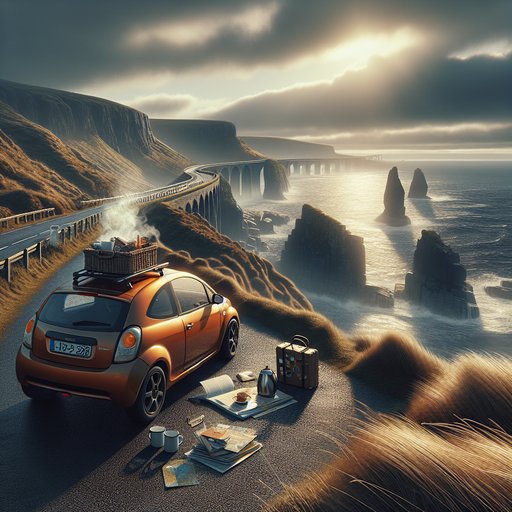
Late October on Ireland’s west coast tests planning as much as driving. Two of us set out in a small manual hatchback to cover a 700–800 km slice of the Wild Atlantic Way from Kinsale to Achill, aiming to use gaps between Atlantic lows. Daylight lasts about ten hours; many clifftop roads are narrow, bridged by single-lane stone arches with posted limits. B&Bs anchor each night, with earlier check-in windows, hot tea, and local advice. Met Éireann wind warnings, tide tables, and ferry notices shape our choices. The goal isn’t speed, but matching weather, roads, and lodging to make a shoulder-season run work.
We started in Kinsale with a simple plan: six days north along the coast, short stages, and no heroics. The car—a compact right-hand-drive hatchback with good mirrors and a modest footprint—suited lanes that often narrowed to grass-brushed ribbons. Our stakes were modest but real: respect yellow/orange wind warnings, never push a headland in a gale, and treat “weak bridge” signs and single-lane arches as non-negotiable throttles on pace. Storm windows would decide our peninsulas.
We watched Met Éireann updates over breakfast and penciled options: Beara via Healy Pass if winds eased; Conor Pass only without gusts; Shannon crossing by ferry if conditions allowed, otherwise detour inland. We also checked tide times for Omey’s sands near Claddaghduff and kept an eye on small-bridge constraints—posted width and weight limits appear suddenly at village edges and over streams on the R-roads. B&B bookings were staggered: first two nights reserved, then day-by-day calls to align with the weather. Kinsale to Kenmare (about 150 km by the scenic line) set the tone.
We skirted the coast past Courtmacsherry and Skibbereen, then climbed through the Caha Pass tunnels to drop into Kenmare as bands of squally rain blew through. Healy Pass, a thrilling alternative, looked exposed, so we passed. Kenmare’s B&B culture was practical: a 4–6 pm check-in, boots off on the mat, radiator in the hall for drying wet gear. Over tea, our host advised that stone-arched bridges on the Beara backroads force courtesy and patience; local drivers expect firm but polite use of pull-outs, never rushing a blind crest.
Kenmare to Dingle (roughly 140 km) hinged on wind. Conor Pass shimmered on the map, but gusts hit 80 km/h over higher ground, so we took the N86 via Camp and Annascaul. In Dingle, we looped Slea Head the next morning during a calm window, easing over several single-lane spans where priority signage settled standoffs. Sea spray blew across the road near Coumeenoole, and we yielded twice for small farm tractors that filled the lane.
That evening, a squall line marched in, and the Tarbert–Killimer ferry posted possible disruptions. We booked a Dingle B&B with a late housekeeping turnaround and made plans A and B for the estuary. The next day we threaded the Shannon during a two-hour lull, hopping the ferry and rolling up to the Burren coast. Dingle to Doolin runs about 180 km this way, but average speed drops to 60 km/h when the R477 hugs limestone pavement and Atlantic views steal attention.
In Doolin, the small bridge over the Aille River narrowed traffic to single file; we waited our turn and idled across. The B&B ritual repeated—tea, a list of dinner spots still open in shoulder season, and a quiet warning that strong swell can close cliff paths. We slept early and targeted Connemara on another brief break between fronts. Doolin to Clifden (about 140 km) and on to Achill (another 120 km) rewarded patience.
The Burren’s coast road gave way to Galway’s bypass and the bog-and-lake mosaic of Connemara. Roundstone’s R341 offered postcard inlets stitched by small stone bridges; we treated each approach like a handshake—slow, signal, yield when in doubt. At Claddaghduff, we timed Omey’s strand for low tide but chose to walk rather than drive, heeding locals’ advice about soft patches after heavy rain. North of Westport, the Michael Davitt Bridge to Achill stood exposed to crosswinds; we crossed in second gear and skipped Keem Bay’s cliff road after a fresh gust rattled the doors.
The Atlantic Drive sufficed—edge enough without courting a closure. We finished with that familiar mix of relief and appetite for more. The lesson felt clear: on the Wild Atlantic Way in shoulder season, the day’s real itinerary is written by storm windows, tides, and small-bridge geometry. B&Bs aren’t just beds; they are weather desks, drying rooms, and route briefings in plain language.
Accepting detours, calling ahead, and keeping the car small turn constraints into a rhythm. We didn’t tick every headline road, but we arrived on time, never forced a bridge or a gale, and learned how the coast rewards modest ambition.












